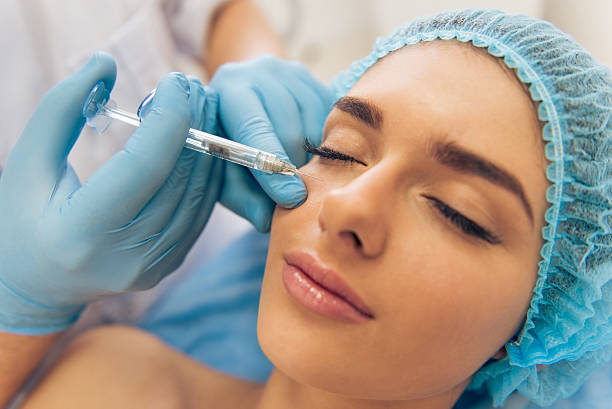




It’s often said that our eyes are the windows to our souls. Although the existence of a soul lacks scientific proof, it’s undeniable that our eyes are the first things people notice. Any imperfections around our eyes and the face in general will be noticed immediately by others. That is why most people look for a way to address such issues as soon as possible.
Among the imperfections often associated with aging are hooded eyes, a concern that can be effectively tackled using a well-known and trusted tool – Botox. The concept of using Botox for hooded eyes might seem unusual to those unfamiliar with its function, but to medical professionals, it’s a logical consideration.
Hooded eyes, characterized by excess skin that hangs down from the brow bone and covers the eyelid, can be attributed to a combination of factors. These include age, genetics, the gradual loss of skin elasticity, lifestyle choices, and sun exposure.
As we age, the skin around our eyes may start to lose its firmness and become more prone to drooping. The natural weakening of the muscles responsible for lifting the eyelids also contributes to the hooded appearance. Moreover, lifestyle factors such as smoking, unhealthy eating habits, and inadequate skincare practices can further exacerbate the issue. Long-term sun exposure can cause collagen and elastin to break down, hastening the onset of hooded eyes. Additionally, genetics can play a role, as some individuals are more predisposed to developing hooded eyes due to their family history. Depending on the severity of the case, Botox can be used to lift the eyelids.
While less common, certain neuromuscular conditions affecting the muscles around the eyes can also contribute to eyelid drooping and potentially influence the development of hooded eyes. The cumulative effect of these factors results in the accumulation of excess skin on the upper eyelids, ultimately giving rise to the characteristic hooded appearance.
A vital distinction one should make is that hooded eyes aren’t the same as ptosis. Hooded eyes are characterized by excess skin hanging from the brow bone and covering the eyelid. Ptosis, on the other hand, refers to the actual drooping of the upper eyelid, which is typically the result of a pathological condition. While the terms are related and sometimes mixed up, they represent distinct conditions with different underlying causes.
Botox’s effectiveness in treating hooded eyes lies in its ability to selectively relax specific muscles involved in brow movement. Medical practitioners can achieve controlled muscle relaxation by strategically injecting Botox into key points around the eyes and along the brow and forehead. This, in turn, counteracts the downward pull of the brow muscles, which contributes to the appearance of sagging upper eyelids. As a result, the brow is naturally elevated, causing the excess skin that contributes to the hooded appearance to lift.
This treatment is particularly suitable for mild to moderate cases of hooded eyes. It offers a non-invasive approach that yields subtle yet noticeable results. Patients can enjoy a rejuvenated and more youthful eye appearance without the need for surgical intervention. However, it’s important to consider that Botox may not be as effective for severe cases of hooded eyes, where excess skin is significant. In such situations, a combination with other methods or surgical alternatives like blepharoplasty might be more appropriate.
When Botox is administered, it typically takes around two weeks for its effects to become fully noticeable, with initial signs appearing within three days. After about three months, the effects gradually begin to diminish, and the eyelids will start reverting to their previous state. By the fourth or fifth month, the results of the procedure will be gone entirely. Patients should undergo regular treatments every four months to maintain the desired effect.
Botox is one of the best well-known cosmetic products known to medical professionals and the general public. It has many benefits and can address not only cosmetic concerns but medical ones as well. Particularly in the context of hooded eyes, several evident benefits come to the fore:
Botox isn’t a wonder drug. Even though you can use it to deal with cosmetic and medical problems, it comes with certain risks. If administered by a trained medical professional, the side effects are mostly negligible and commonly include the following:
More serious side effects are primarily associated with the inexperienced administration of Botox, yet in exceedingly rare instances, they may manifest even with meticulous precautions in place. If patients notice any of the following side effects, they should seek immediate medical assistance. These side effects are:
If the patient’s case is so severe that Botox is no longer an option, alternatives should be considered, but Botox can also be used in combination with them. Some good alternatives are:
While Botox is FDA-approved, the use of Botox for hooded eyelids is considered an off-label use of this well-known product. It’s a testament to innovation that we continue to discover novel applications for a product that was first FDA-approved in 1989, more than three decades ago.
With ongoing advancements in cosmetic and medical procedures, the world of aesthetics is constantly evolving. Botox serves as an example of the synergy between medical expertise, technological progress, and patient aspirations.
As we move forward, the journey of discovery and innovation continues, offering new possibilities to those seeking effective solutions for their aesthetic concerns. But for now, Botox is a dependable solution for your patients’ concerns while we stand ready to assist you in sourcing the essential tools for your practice.
Count on Maylips to be your steadfast supplier in providing the tools you need to bring beauty and confidence to your patients, making each treatment a success.
You can use Botox for hooded eyes as long as the hooding is mild to moderate.
You will typically need between 4 and 8 units for the outer eye and between 20 and 30 for the area between the brows.
Botox is an effective, non-invasive way to deal with saggy eyelids, as long as the case isn’t too severe.

